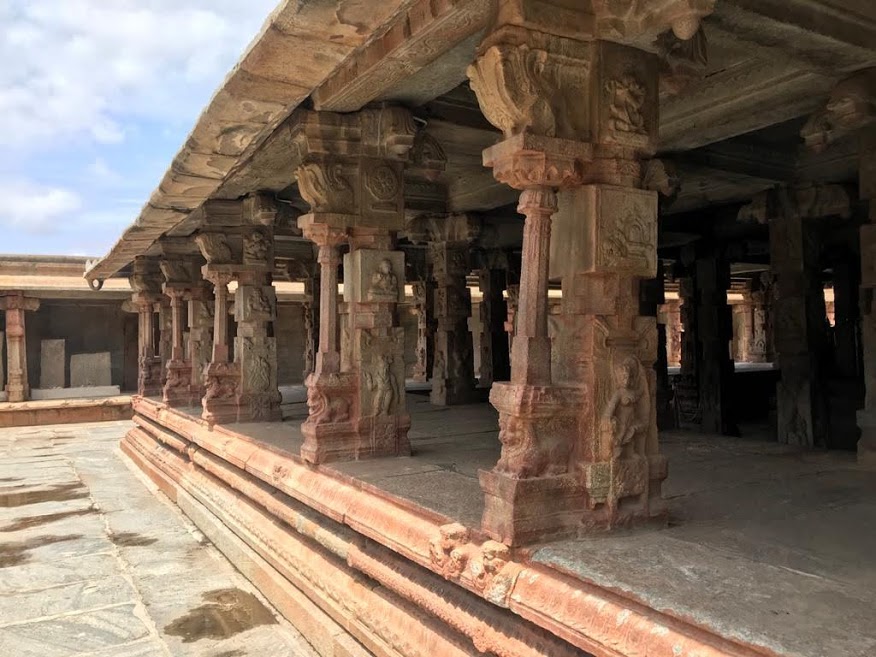Thankful to the Good Lord that I reached my 55th milestone on this planet last month! With all the Covid restrictions, there was no way to make the day special, other than by driving out in the outdoors away from the madding crowds, and we zeroed in to drive to the famed Bhoganandeeshwara Temple. Having lived in Bangalore for over two decades, for some reason we had not made a visit to this temple.

We drove the distance of 122 kilometres from Whitefield to the temple via the Budhigere road to Devanahalli to hit the Chikkabalapur Road. It took us an hour and half to arrive at the quaint village of Nandigrama located in the Chikkabalapur district of Karnataka. The signage outside and the grandeur inside were a subject of contrast. But there was no doubt that I was struck by the architecture as well as the size of the temple. The temple is surrounded by mammoth trees and landscaped wild grass and it is a pleasure to see a variety of birds that were chirping and flitting about from one tree to another. Built in the early 9th century, it is arguably one of the more ancient temples in the vicinity.



It is believed that the earliest inscriptions found in the temple can be traced back to the Nolamba dynasty, who were a native Kannada dynasty ( Nolambadiraja) and the Rashtrakuta Dynasty (during the reign of Govinda III), Circa 806 AD. It is said that Rathnavalli, the queen of Bana dynasty (of the eighth and ninth centuries) built the Bhoganandishwara temple which flourished for more than thousand years during the reigns of Hoysala, Chola, Pallava and Vijayanagar empires.
Hence, the architectural impressions of five different ruling empires seamlessly inter-mingle in the grand walls, pillars and patterned ceilings.


The temple has all the essential rudiments of a typical Dravidian temple. This include the sanctum or ‘vimanam’, the ‘mandapam’ or hall, the towers or ‘gopurams’ and a temple tank.
There are three individual shrines in the temple for Arunachaleshwara, Bhoga Nandishwara and Uma Maheshwara. The Arunachaleshwara form represents the childhood of lord Shiva, The Bhoga Nandishwara represents the youth and the Uma Maheshwara represents that stahe of life when Lord Shiva is married to Goddess Parvati. Hence, this temple is a popular destination for young couples who come to seek their blessings. Well, my spouse and I just completed 30 years too, and it was a happy coincidence that we were here together this year. Each shrine also has a Nandi mantapa in front. The vestibule and hall are provided with perforated stone screens called jalis.



The stage of renunciation – the Yoga Nandishwara can be found at the temple atop the Nandi Hills, where we had a chance to visit too. The temple also has a vigraham of the ‘Ugra Ganapati’.


The temple walls have beautiful, intricate carvings of various deities and demi-gods. To the north of the shrines is a second compound with a navaranga mantapa (pavilion) with pillars engraved with figures of the Yali. The Yali is a mythical creature which is part lion, part elephant, and part horse. Beyond this compound is a large stepped temple tank, the Kalyani or pushkarni , called the ‘Sringeri Teertha’ (the mythical source of the Pinakini river). The name Pinakini refers to Pinaka, the bow of Nandhiswara, the presiding deity of the Nandi hills at the origin of the river. The river is also known as the Penna River and has several sources and mouths at the Nandi Hills.

I leave you now with the pictures of the temple. Close to Bhoganandishwara temple is Muddenhalli, the birthplace of Sir M. Visvesvaraya, which I will cover in another blog.





N.B : Share, Subscribe, and press on the star – if you liked the article 🙂

👍❣️ like it
LikeLike
Thank you so much!
LikeLike
Loved reading this!! As always very descriptive and I got virtually transported there !
LikeLike
Thank you so much Shoba for your appreciation!
LikeLiked by 1 person
Wow .. thanks for writing this article so beautifully…got transported virtually there… would definitely love to visit this… thanks to your description…as usual your writing is eloquent 😍👌👌
LikeLiked by 1 person
Thank you Shilpa 🙂
LikeLiked by 1 person
Wow, very well articulated sangeetha. Eager to visit the place soon. Thanks for sharing this
LikeLiked by 1 person
Thank you so much Sakunthala.
LikeLiked by 1 person
Lovely write up……love your language…you feel u are there .
LikeLike
Thank you so much Geetha!
LikeLike
Pingback: Yoganandeeshwara Temple atop the Nandi Hills ©Sangeeta Venkatesh | sojourn-with-san
Beautiful! especially the temple tank which is majestic.
LikeLiked by 1 person
Pingback: Pearls Across Penna Trail – Day 1 (part 1) SriKalahasti Temple & Kalamkari Artists ©Sangeeta Venkatesh | sojourn-with-san